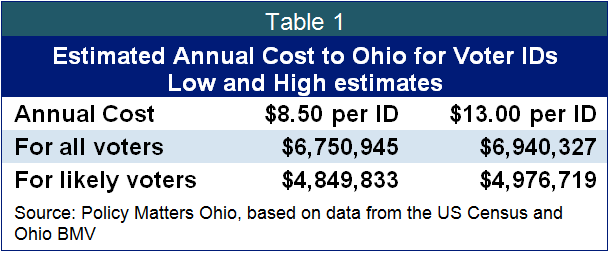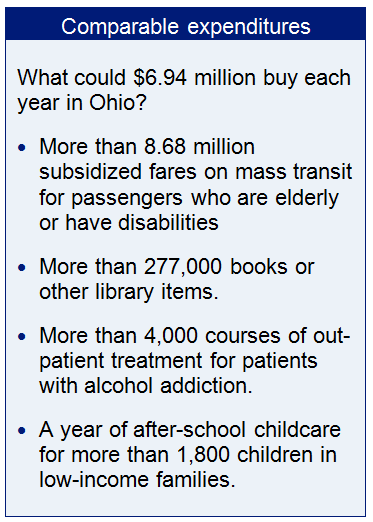
Pam Rosado's prepared testimony for US Senate field hearing on Ohio voting law
May 07, 2012
Pam Rosado's prepared testimony for US Senate field hearing on Ohio voting law
May 07, 2012
If there is a problem with voting in Ohio, it is that too few people are doing so because of existing barriers. Creating new, unnecessary costs and suppressing votes has no place in the Buckeye State.
Pam Rosado, Outreach Coordinator
Senator Durbin and Senator Brown,
Thank you for the opportunity to testify today. My name is Pamela Rosado and I am the outreach coordinator for the non-partisan policy research institute Policy Matters Ohio. I have long served on the Greater Cleveland Voter Coalition. Today I would like to summarize new research released by our organization just last month, from a study called Ohio Photo Voter ID: A picture worth $7 million a year?, written by my colleagues Sana Haider and Amy Hanauer.
The United States was founded on the ideal of government by consent of the governed. Voting is the means by which we express and achieve that consent. Throughout US history we have expanded the right to vote – to non-propertied men, African Americans and other people of color, women, and young adults. Recently in Ohio and other states, lawmakers are going in the opposite direction, proposing new restrictions.
A bill requiring photo identification to vote, HB 159, was approved by the Ohio House of Representatives in March 2011 and a slightly different Senate version has been introduced. Legislators have passed laws requiring photo voter identification in 17 states, nine of which are strict laws like the Ohio proposal.
The version of this bill passed by the Ohio House requires all voters to have photo identification, but provides free ID cards only to qualifying low-income voters who request the card and can prove low income. The Senate version would provide free cards more broadly. It is unclear whether either version would withstand a legal challenge.
In Ohio, we estimate that approximately 938,642 Ohio adults lack photo IDs.
Costs
 We have two different cost scenarios for the IDs and two different projections of how many cards would be needed. We can assume an $8.50 cost – the current cost of a state ID in Ohio. At this price, the annual cost would range between $4.85 and $6.75 million, depending on whether we provided the IDs to all eligible voters or just the percentage who voted in the last presidential election.
We have two different cost scenarios for the IDs and two different projections of how many cards would be needed. We can assume an $8.50 cost – the current cost of a state ID in Ohio. At this price, the annual cost would range between $4.85 and $6.75 million, depending on whether we provided the IDs to all eligible voters or just the percentage who voted in the last presidential election.
Alternately, we can assume a $13.00 cost, the actual cost that Indiana faced when it implemented voter ID requirements. At this price, the annual cost would range between $4.98 and $6.94 million, again depending on whether all voters are given one, or just the 67% who voted in the last presidential.
Comparable Expenditures
 Ohio is cutting spending on many essentials. We cut $95 million from the budget, including cuts to education, police and fire protection, drug treatment, disability services, and disease prevention, under House Bill 487. The state has even cut local election board funding, making it more difficult to staff elections and forcing reductions in polling places. HB 159 would inject a new unfunded mandate in this environment.
Ohio is cutting spending on many essentials. We cut $95 million from the budget, including cuts to education, police and fire protection, drug treatment, disability services, and disease prevention, under House Bill 487. The state has even cut local election board funding, making it more difficult to staff elections and forcing reductions in polling places. HB 159 would inject a new unfunded mandate in this environment.
The $6.94 million in annual costs could instead be used for other important priorities in Ohio. What other services of benefit to Ohio families could the state instead purchase for this amount?
- More than 8.68 million subsidized fares on mass transit for passengers who are elderly or have disabilities;
- More than 277,000 library items, including books, reference books and movies;
- More than 4,300 courses of treatment for patients with addiction; or
- More than 1,800 subsidized slots of after-school child care for children in struggling families.
According to the Brennan Center for Justice at NYU School of Law, the courts require that state photo ID laws meet criteria currently missing from HB 159. States must provide free IDs to all those who lack them, provide free birth certificates, expand the number and hours of ID-issuing offices, and undertake substantial voter outreach to ensure voters know the requirements. These requirements figure into the costs.
Disparate Impact
More than one in ten Ohioans lacks a photo ID. The new requirements would have a disproportionate impact on elderly voters, young adults, minority voters and low-income voters, all of whom are statistically less likely to have an Ohio driver’s license. Who lacks photo IDs?
- About 290,000 Ohio seniors - 18 percent
- About 260,000 black Ohioans – a staggering one in four
- At least 380,000 moderate-income Ohioans (earning less than $35,000) - 15 percent in this income range
- College students and voters without cars are also less likely to have valid photo IDs.
Conclusion
HB 159 is likely to suppress voting in Ohio. The bill purports to solve the virtually non-existent problem of voter impersonation, but will instead create new voting problems, and at a steep new cost. Ohioans value the right to vote and they value their neighbors’ participation. If there is a problem with voting in Ohio, it is that too few people are doing so because of existing barriers. Creating new, unnecessary costs and suppressing votes has no place in the Buckeye State.
Thank you again for the opportunity to testify today.
Tags
2012Budget PolicyDemocracy & GovernmentPhoto Gallery
1 of 22